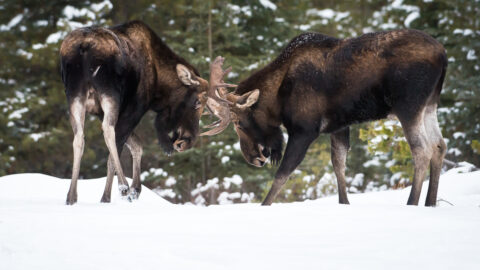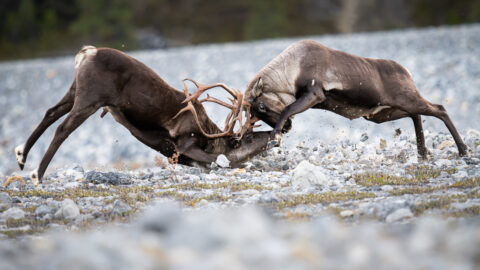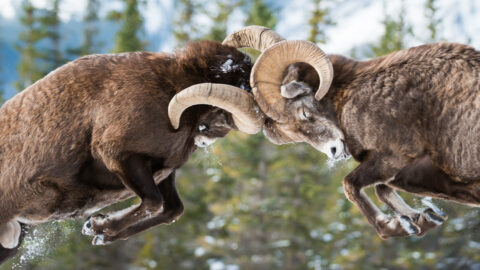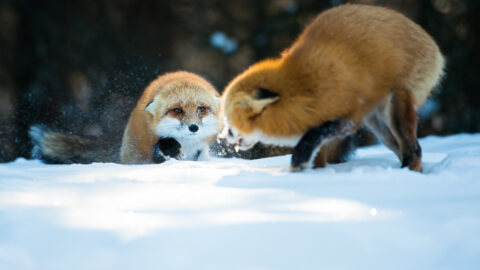Estimated Read Time: 21 minutes
Save the economy to save nature?
Chapter Three
Look, despite what a few Twitter trolls want us to believe, no one wants to destroy Canada’s economy and no one wants to recklessly endanger our natural environment either. So, let’s just put that out there first.
But the syrupy promises of win-wins aren’t always realistic either.
Sure, we can reject the question of whether we should prioritize nature to help the economy or prioritize the economy to help nature as being a false choice. We can hope and want and even work towards an answer that tackles both issues simultaneously.
But that vaunted Canadian compromise? Yeah, not everyone loves it.
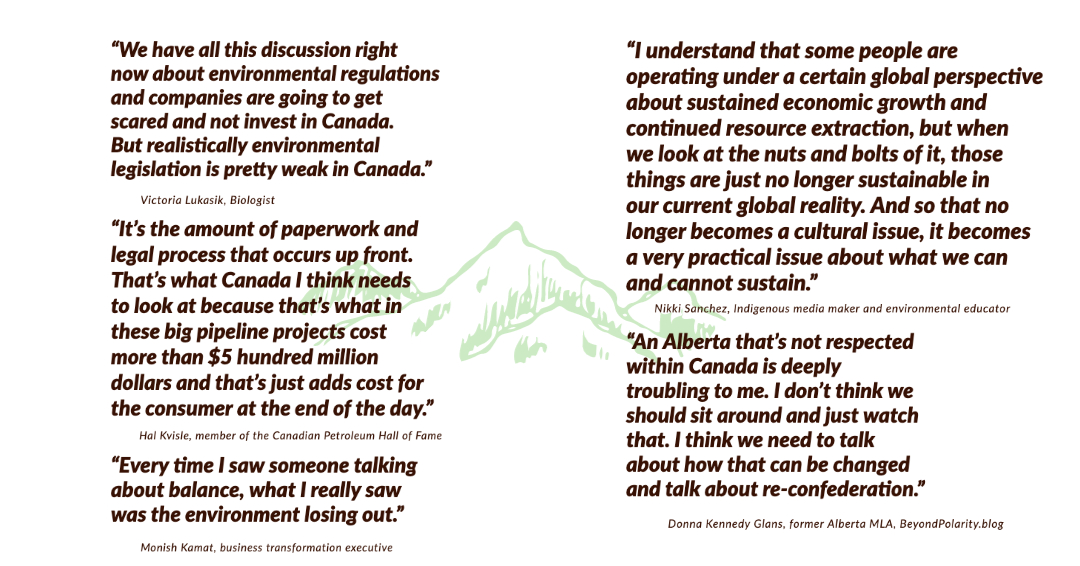
What’s often billed as a win-win, as you heard, is increasingly seen as a lose-lose. After all, small decisions – mushy compromises – aren’t yielding the wins needed to revitalize the economy or nature. It’s why for real change to happen, we need to hear this bit of honesty from Ken Wu:
“There are going to be winner and losers.”
The founder of Endangered Ecosystems Alliance is saying the quiet part out loud – something most know, but many are afraid to admit. But it’s refreshingly honest and he’s not wrong. No matter the solution, there will be some losers.
And though Ken adds “we don’t have to have as many losers as people often think”, the reality is the idea of having any losers in a major policy decision with social, environmental and economic reverberations doesn’t sit well with a lot of us.
Why?
Because no one wants to be the loser; everyone is afraid they’ll be the loser. People are worried that it’s their closely held ideals and their deeply ingrained values that will be sacrificed at the alter of tough decisions.
And those tasked with making the hard decisions? They have to live with the consequences – the fall-out.
Because we’re Canadians and we don’t like to offend, we pretend the problem doesn’t exist and we punt it down the road and hope like heck it goes away.
But it doesn’t. And it festers. The fear? It grows and grows, until it explodes.
We all have to live with the real consequences of pent-up anger and resentment of those who think they’re losing – or those who fear they will lose when all is said and done.
It’s how divisions start. It’s why we have demarcation lines all across society: Indigenous and non-Indigenous; English and French; east and west.
And those are real divides that stem from real feelings of disenfranchisement – real feelings, albeit to varying degrees, of injustice and powerlessness.
But there is another chasm in our society that might be the biggest of all: The rural-urban divide.
It’s not new – it started in about the year 1900 when cities started becoming a thing – but it’s growing and has never been more pronounced than it is right now. In fact, the question of whether we should prioritize nature to help the economy or the economy to help nature is at the very heart of this divide, explains pollster Shachi Kurl.
“The intersections here get pretty complex pretty quickly, and I think so much of the division on so many issues in this country has really been boiled down to: ‘it’s this or it’s that’. It can’t ever be both. And: “this one is right, that one is wrong’.”
For rural communities, Shachi tells us, “it doesn’t matter if you work at the Tim Horton’s and your job depends on the customers coming in who work in the [oil] patch, or if you’re someone who’s working a rig. Their view’s very much ‘we’re just trying to make a living’.”
Whereas, Shachi says, many living in urban centres counter with “hold on – we have to inherit this mess. They’re not hearing what they need to hear either, they’re basically hearing a lot of crickets chirping.”
In other words, each side of this question fears the other doesn’t understand the stakes; they don’t see their political opposites meeting them halfway. As a result, the urban-rural divide is becoming an open fault line in our democracy that, consequently, is threatening our democracy.
“But ultimately, the only way we’re going to get to a place where everyone is sort of buying into something is if they all feel like whatever it is they are hearing is acceptable or palatable to them. And I think in the era of social media, we have lost the ability to question respectfully without being accused of either being a terrible person, or not being patriotic or this or that.”
Donna Kennedy-Glans agrees.
“I am deeply concerned about confederation in Canada.”
Donna is a former Alberta cabinet minister and headed up the Alberta Fair Deal Panel, which sought to hear the grievances of rural Alberta.
“You do have to understand what motivates somebody. Why do they feel that way?”
Donna says everyone needs to understand that “we have layers and layers of identity and values that come to us from the way we were raised, from the people we love and respect, from the place where we live.”
Donna explains the fear each side feels is real and needs to be addressed.
“Coming to some reconciliation of what that can look like in a place like Alberta, I think is a lot of work, and it changes. And I think figuring out how to get peoples voices heard and understood on those kinds of things is imperative. It’s out imperative. It’s what we have to learn to do better.”
Sean Mullin is the founding executive director of the Brookfield Institute and an economist by training. And he agrees we need to find solutions that work for both solitudes.
“I really think that that’s the only way we can solve it.”
And it’s both more urgent and more challenging, because as Sean explains, “one of the clichés you hear out there a lot is how the world and the economy and the rate of change is ever increasing. It’s both a cliché, but’ it’s true.”
And that’s especially so in the wake of COVID-19.
Disruption? Uncertainty? Change? That’s deeply unsettling for many of us.
“It’s a hard thing to get our heads around. I mean, challenges are new and different all the time.”
But just because change is happening, doesn’t mean everything is going to change. As Sean tells us, the resource economy, “I think it will always be a part of Canada, it will always be an advantage we have, we need to think about how we’re shifting a greater portion of our economy towards knowledge-based industries.”
And though that might be important to the sum of the whole, in a more automated, technology-forward, environmentally-friendly world, even slight shifts will change the market economics of resource development. That means fewer jobs and fewer communities of people who will be employed in those jobs.
It’s why Joel McKay says, “the policy, frameworks and structures we use to order our country are not conducive to rural development.”
Joel is the CEO of Northern Development. He advocates for rural communities and rural economies.
“Eighty per cent of the population of Canada lives within two hours of the U.S. border, and the vast majority of those individuals live in our major cities, which are quickly becoming city states. Canada, and its provinces, need to have a serious look at how we recognize and support rural development.”
And for Joel, that’s recognizing a simple truth.
“What needs to be realized is that rural communities, especially those in the north, have few realistic options for private-sector employment that are outside of natural resource industries.”
That means, for the 909 communities in Canada that rely on the resource industry, some communities simply won’t be able to survive if the economy shifts away from resource development, according to Joel.
“We need an environment that supports resource extraction, attracts investment and leverages the benefits generated from that to reinvest in rural areas so that they have just as much opportunity as our urban areas.”
If that doesn’t happen? Some fear they will be the ones who will lose work – some fear it will be their community that doesn’t survive.
That fear is both founded and unfounded. Let me explain.
Mount Robson’s Elliott Ingles tell us, “these small communities [like Red Pass and Lucerne in Mount Robson] popped up along the railways. This was life, that was how people were living.”
Of course, both of these locations are now part of Mount Robson Provincial Park and have been for a long time. And it’s been an even longer since these places were more than ghost towns.
Why?
Change, of course.
Red Pass and Lucerne were by-products of a by-gone era – one where travel and trade was limited to the railroad. Train and track maintenance requirements often dictated where towns were established – and brought settlers to these outposts in search of work.
And though the railway still runs past the ghost towns of Lucerne and Red Pass, the maintenance needs have changed – the employment requirements have changed. The consequence? Towns faded away.
Indeed, in many parts of the country, towns came and went with the railway, but the ones that survived evolved from rail-based tourism and focused on what nature provided: Natural resources. And as local community builder Bruce Wilkinson explains, Valemount was no different.
“It wasn’t tourism based when we moved here, it was the forest industry.”
Bruce Wilkinson – yes, the resident streamkeeper – is also the godfather of tourism in this region.
“BC provincial parks offered an opportunity to run a business in the park, which hadn’t happened before.”
It was a turning point – not only for Bruce’s career, but also for the community of Valemount.
Why? Because nothing is static, and just as railway-driven business changed, so too has the forest industry, as you now know, due to changing economics and the pine beetle infestation.
That meant, to survive, Valemount needed to rethink what nature offers the community, Bruce explains.
“I think that communities have to find out what their uniqueness is. What do we have that others don’t have? That had to happen here with downturn in the forest industry. Well, what do we have? We have tourism. This building we’re standing in now came out of a big seminar we had about what can we do because forestry has had a downturn.”
That’s the thing with natural resources – it’s a cyclical industry. Sometimes it’s boom and sometimes it’s bust. And it’s not that forestry no longer matters to Valemount, Bruce tells us.
“We needed forestry too. I never, ever was against forestry, but now we have opportunity.”
That opportunity, Bruce says, is tied to Mount Robson.
“Mount Robson Provincial Park is known around the world, Valemount isn’t known at all.”
Which isn’t to say people living in Valemount – or in many rural communities across Canada – are willing to let go of what they know for the promise of something new.
According to Bruce “in Valemount, when we moved here in ’86, there was a vibe where people didn’t think the park did anything for them. I had a hard time selling that we should be tying the Valemount flag to Mount Robson Provincial Park.”
For that reason, according to local historian Art Carson, many living in Valemount were “quite upset that the area is not open for logging. They have seen that as basically outsiders putting nature ahead of human beings.”
The animosity to the park is understandable, Bruce believes.
“They can’t see a benefit of people coming and camping out there, even though they’re buying their groceries here which keeps our grocery costs lower.”
As Bruce has helped connect the dots between Mount Robson’s protection and economic opportunity, others in the community have bought-in, like Loraina Stephen, who’s business now runs park operations.
“The jobs and the positions that we have contribute hugely to the economy.”
And that might make you think that as economies change – as times change – communities will evolve, just as they always have.
“I don’t know that everyone sees the value of the park as part of the community.”
How is that possible? Well, here’s the thing: Communities fear the consequences of economic loss, absolutely, but equally they fear a changing culture.
As work changes, so too does the fabric – the values – of a community. That can be disruptive.
Also disruptive? What’s required of a community to meet the needs of the new economic opportunity, and Sierra Daiken-Kuiper, a cultural anthropologist explains.
“Most of the people I talked to all had the same underlying value, which is that they really cherished the landscape and really liked being outdoors, a lot of the people that were opposed to the national park were concerned about the area being turned into a tourism destination.”
Sierra grew up in Lethbridge, Alberta. She’s investigated why rural communities, struggling for economic opportunity, oppose conservation measures like parks.
Sierra says her research showed that tourism infrastructure like “roads, campgrounds that sort of thing, that would actually take away what they so loved and really valued about that landscape.”
In other words, a park might create jobs – more jobs, better jobs – to augment natural resource extraction, but some people just don’t want any old job; they want the job they know and the culture it helps protect.
Bruce Wilkinson believes communities need to embrace change if it means sustaining the community’s existence.
“It’s harder for us to get in, but I like that. That tells me that they community is doing well, and the community will survive.”
But Sierra Dakin-Kuiper says we need to, “think critically about how people were reacting and responding and thinking about the problems in their lives.”
And in this case, it’s recognizing that slight changes to the national economy will mean big changes to some local economies – and big economic shifts in a small town will almost always result in big cultural changes.
Northern Development’s Joel McKay says this is why “economics is critical because it speaks to how human beings have structured our societies and the methods we use to improve our personal and societal well-being.”
In other words, it’s never as simple as economics versus the environment. It’s really culture versus culture and how the economic choices we make often determine cultural outcomes.
Joel adds, “unless we re-structure every society on Earth to function under an alternative system, economics will continue to…be an underwriting fabric of the human experience.”
It’s why Joel believes “we need an environment that supports resource extraction, attracts investment and leverages the benefits generated from that to reinvest in rural areas so that they have just as much opportunity as our urban areas.”
Opportunities that reflect the local culture.
And that, says BC’s former Lieutenant Governor Janet Austin, is the crux of the issue.
“Try to understand – what are the reasons people hold the views they hold.”
And in many ways, that begins with understanding our history – understanding why similar western provinces like BC and Alberta have evolved differently, Janet tells us.
“When we look at Alberta and British Columbia, we have two societies, two economies that really have developed through resource extraction. British Columbia, I think, has been more successful of diversifying our economy.”
Why? Janet, born in Alberta and now forging a life in BC, says of her adopted province: “Our society, our population, is more diverse. So there’s less uniformity, which has actually created opportunity which may not have existed elsewhere.”
BC’s proximity to Asia, Janet argues, has allowed diversity to blossom in its major urban centre, Vancouver, and that’s changed the fabric of the entire province’s economy. Landlocked Alberta, on the other hand, is less diverse because of its geography and remains more focused on its geography: natural resources.
Though Janet is referring to regions, the same holds true for the urban-rural divide. As Jen Gerson in The Line wrote: “We all have our own culture. It is informed by our history. And if we’re only exposed to one culture – one history – our values won’t shift for we don’t know any better.”
But exposing one culture to those of others isn’t easy because it means change, and change is never comfortable. It’s why Janet says, “I think we need to advance change as rapidly as we possibly can and as rapidly and as proactively as our society can manage it. But we need to recognize that change does take time, and cultural change is part of that.”
That’s why Janet believes “if we want to move forward on any major social, cultural, or environmental change, we need to bring people along, we need to engage people.”
It’s one reason why reconciliation appears so stuck, Janet Austin tells us.
“I worry a bit that the discussion about reconciliation is being placed at more of an elite level, and unless we’re actually able to capture the imagination and the understanding of our population more broadly, we won’t achieve the success that we need to achieve.”
To make cultural change – reconciliation, in this case – more understandable, it helps to find commonalities. And interestingly, one commonality is this: what many rural resource communities fear losing – their culture and right to self-determination – is what many Indigenous communities have already lost.
Take the settler-imposed decline of the bison and the realized fear of cultural loss, says Indigenous leader Leroy Little Bear.
“It has a whole bunch of cultural roles that it fulfills for our people because without it, hey – I’m just a little bit less Blackfoot.”
Leroy explains what that means.
“Being a little bit less Blackfoot with it’s absence, it would be similar to Christians. And in our modern world, you know for instance, we have hey – sacred Christian places we go to. What if all of a sudden, The Vatican was no more, say? Well, you could still have all the church beliefs, you could still have all the Christian beliefs, you could still practice them, but without that kind of iconic symbol out there, see, there’s something missing. If the churches were taken away, or all closed down, hey – you could still have all the beliefs, and the people still have all the beliefs, but they were just a little bit less Christian.”
That’s loss. Thanks to Leroy, it’s loss we should be able to understand.
It’s why when you change the names – Little Fort and Valemount, Fort McKay and Fort McMurray – what you begin to realize is that the fears, the anger, the needs, the wants aren’t that different between the communities, minus the seismic difference of history. One fears what the other has had taken away, forcibly.
This could be – should be – a common starting point to build bridges between different cultural communities, to advance reconciliation and even to tackle issues at the intersection of people and nature. After all, as Shianne McKay of the Centre for Indigenous Environmental Resources says, “you can’t really address the environmental issues in the face of poverty, you have to address both.”
But, of course, that also means finding solutions that mesh with the local culture.
“There’s over 620 First Nation and Métis and Inuit organizations and committees across Canada with diverse cultural backgrounds.”
And as Indigenous environmental advocate Myia Antone adds, that means we need to ask, “how can I help their community in ways that they need to be helped, and want to be helped.”
Want being the key word.
Sounds familiar, right?

Yet what should be a commonality – a starting point – isn’t, according to a MacLean’s Magazine investigation.
Why?
Well, it might have something to do with this: most Indigenous communities in Canada are rural. If the economy is changing – and it is – and there are only so many jobs to go around – and there are – what happens if or when every rural community can’t be saved? What happens when, or if, some communities we see on the map today follow in the footsteps of Red Pass and Lucerne?
Does every community even deserve to survive, if communities have naturally ebbed and flowed across the centuries? What communities can economically survive? What communities and their cultures must survive? And who gets to make that call?
Then there’s this:
Saving rural communities might require government subsidization – in fact, in many ways, it already does. It’s the type of greater-good, liberal policy urbanites usually rally behind. Yet will they rally to save communities that, in the saving, might impact environmental and social goals of urbanites? And what of rural citizens – a population that increasingly votes Conservative and is against government intervention? Will they support government intervention – policies that go against the very bedrock of conservative philosophy – if it means saving their own town or culture?
And what happens when all of this collides with issues of social justice and reconciliation?
Ethicist Kerry Bowman reflects.
“It’s very tough. It’s very tough indeed. Why should they have this, and why should that be protected, when I’m living in a state of poverty. And I don’t have a good answer for that. I don’t, I’m struggling with these things.”
See? It gets messy fast. What we assume should be an easy, middle-of-the-road compromise between helping nature to help the economy and helping the economy to help nature quickly becomes more complicated.
And so maybe the better question isn’t what should we prioritize first, but how can we bridge the urban-rural divide? Or better yet, can we bridge the urban-rural divide?
Can we balance urban and rural cultures and safeguard biodiversity and advance reconciliation? Is it actually possible to have our cake and eat it to? And if the answer is no, what does that mean for the hard decisions we face? What does that mean for the future of our democracy itself?
We need to be honest that the sum of the parts is different than the parts that make the whole. We can’t generalize and hope for someone else to solve this issue for us.
Canada should be able to bridge this divide. It might be mostly possible. But will it always be possible? And what happens if it’s not possible? Or not possible in every region? What community is it appropriate to sacrifice? What animal can we afford to let go?
If we’re not prepared for these questions – this possible collision – we won’t know what to do when it happens. And then everyone loses.
This is why we need to know what we don’t know and what we don’t want to know. This is why we need to ask the better questions, always and relentlessly.
Look, no matter where you stand on this issue – no matter how you feel about the opinions of those voiced in this story – we must remember that everyone is entitled to their perspective, their grievances and their fears. Minority views need to be heard. Majority views aren’t irrelevant. Rural views matter, just as urban views do too. We don’t have to agree with those we disagree with, but we must learn to live with those who have differing opinions from our own.
And though it’s tempting to go with the solution that solves the most problems at once, former Alberta cabinet minister Donna Kennedy-Glans reminds us:
“If you’re going to come up solutions about how to make your park better, it means you have to really understand the detail and the complexity and the options. If you take one option off the table, what does that mean for something else?”
Like what? Well, how about this, says ethicist Kerry Bowman: “I mean, the risk with community involvement is that the voices of non-human life are not there. So we all have to be very careful because communities can say, ‘do this’ or ‘do that’, but you’re still not factoring this multitude of species and biodiversity and the whole web of life.”
And then there’s this, says Northern Development’s Joel McKay: “The policy, frameworks and structures we use to order our country are not conducive to rural [communities]. In order to bridge that challenge, we must have a hard look at how we structure everything”.
Sometimes when we wish and hope for something to be true, we gloss over hard truths. And when we do that? Win-wins suddenly become lose-lose scenarios. Sometimes people don’t get heard. Sometimes resentment builds or species disappear and then:
“When we talk about social justice, well who’s facing the injustice as a [result]. Every action has a reaction.” – Shachi Kurl, Pollster
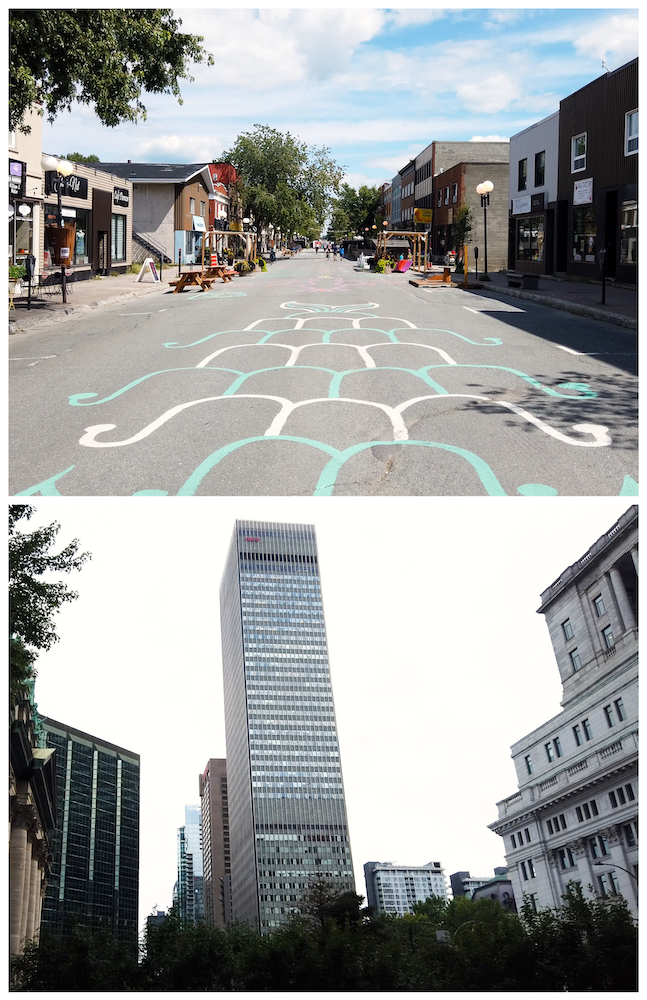
What do you think?
Task
Gather in small groups and discuss the following:
Terms & Concepts
Referenced Resources
* Quotes have been edited for brevity and clarity.
